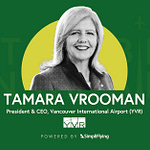The Dubai Airshow is a spectacle of cutting-edge aviation technology: gleaming aircraft, ambitious order announcements, and bold visions for the future.
But beneath the fanfare, one question keeps surfacing in every conversation, every press conference, every closed-door meeting: Can the Middle East’s aviation boom and sustainability ambitions actually coexist?
Over the week, we sat down with five leaders shaping the future of aviation across the region and beyond, including:
Paul Griffiths, CEO, Dubai Airports
Julien Manhès, Head of Sustainable Aviation Fuels and Carbon Dioxide Removal, Airbus
Yousif Bin Saeed Al Lootah, CEO, Lootah Biofuels
Darren Hulst, Vice President of Commercial Marketing, Boeing
Michel Azar-Hmouda, President of Commercial Aviation, CAE
We asked them all the same closing question: Where do you see the region’s greatest opportunities to lead in sustainable aviation innovation, and what potential pitfall could undermine that progress?
This episode brings together a selection of their answers — recorded live in partnership with the Dubai Airshow 2025 and CAE. Full interviews with each guest will follow in the coming weeks.
Why the Middle East matters
When we asked these leaders about the Middle East’s potential to lead sustainable aviation innovation, several common themes emerged.
The region’s strengths are clear: massive infrastructure investment, operational excellence at major hubs, strong government commitment, and access to capital.
Add to this abundant renewable energy resources and the region’s central geographic position, and you have a compelling foundation.
Three takeaways from the conversations
With existing expertise in energy production and a track record of deploying innovation quickly, the Middle East is positioning itself as a proving ground for sustainable aviation technologies at a commercial scale.
1. A hotbed of opportunity
Beyond the structural advantages, the region’s geographic position matters too. Sitting at the crossroads of global aviation, connecting East and West, Europe to Asia, the Middle East handles enormous volumes of traffic.
This creates opportunities to validate technologies and demonstrate that sustainable aviation can work at scale. With fleets in the region expected to more than double over the next 20 years, whatever innovation happens here has the potential to influence global aviation.
2. The execution challenge
But optimism must be tempered with realism. While ambition is easy, execution is harder. Every leader we spoke with was candid about the challenges ahead. Workforce development emerged as a pressing concern, with forecasts suggesting 1.5 million personnel will be needed globally over the next decade. Infrastructure must keep pace with growth. Supply chains need to be built out. Coordination across governments, airlines, and fuel producers requires sustained effort.
3. Pragmatic optimism
The question isn’t whether the Middle East has the resources or ambition. It clearly does. The question is whether it can turn those advantages into demonstrable results that provide a blueprint for how sustainable aviation growth can work globally.
What emerged from these conversations was a pragmatic optimism: an understanding that this is difficult, that timelines are tight, that coordination will require effort, but also a belief that the Middle East could actually pull this off.
Sustainable aviation isn’t optional anymore. The world is watching the Middle East to see if it can set the pace.
This episode was made possible by CAE, whose commitment to sustainable aviation training and innovation continues to support the industry’s journey towards decarbonisation.













